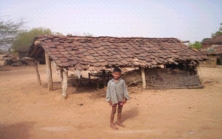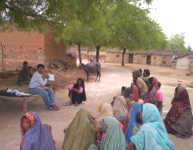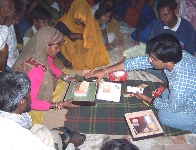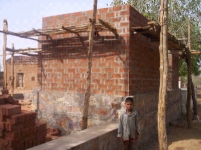The
project to facilitate sustainable habitat in rural Bundelkhand “Housing
Delivery and Habitat Development, District Tikamgarh” The project is being implemented in the village Mador of Niwari Block in District Tikamgarh, Madhya Pradesh.Vision The project aims at establishing sustainable processes for upgradation of habitat conditions in rural Bundelkhand. This vision is being realized through the following objectives
Project Process As part of the innovative housing construction project in Village Mador, various novel processes have been initiated. For the first time in Bundelkhand, such a project is being executed wherein the beneficiaries are involved as major stakeholders, while major part of the contribution (67%) is external.
A
Village Development Committee (VDC) has been formed, comprising 12
elected members. Men and women as well as A simple management system has been introduced in the project wherein the VDC manages the local activities with regular inputs from the qualified professionals of Development Alternatives at Orchha. A participatory design meeting was organized with the families in March 2005. Various models in terms of designs of dwelling units were shared with the local community and the families were given a free hand to put forward a design they liked. Gender related issues were discussed, during which women expressed their views about the kitchen and toilet spaces. On the basis of the needs of the families, the designs of dwelling units were finalized. A broad choice of materials and technologies was also provided to the families with the help of experienced masons and communication posters and the families, like tough customers cross-questioned the technical team about the various advantages of improved technologies and building materials. At the end of the meeting, the community agreed on a combination of stone masonry and rat-trap bond brick walls and micro-concrete roofing tiles. More emphasis was given on the improvement in living spaces as well as optimum utilization of local resources during this meeting. Project Implementation As the first step of the project, the families are encouraged to submit the earnest money (Rs. 2000). Apart from the cash payment, a family is supposed to contribute labour and building materials for its house. As a strategic step, construction of the community buildings have been initiated prior to that of the dwelling units in order to demonstrate improved construction technologies to the villagers; boost the income of labourer families and train the VDC in systems of record keeping and construction management. Monsoons being around the corner, it was insisted to start the construction and complete a few dwelling units as well. Current Status
The names of VDC members have been painted on a wall of the village with their roles and responsibilities. Good construction guidelines have also been painted. While motivation activities were being initiated in the village, six village masons have received a training in stone masonry at TARAgram. Currently, two villagers are receiving RCC chowkhat training at TARAgram, which they may take up as an enterprise to supply door and window frames for the project or sell it locally. Impinging Impediments The project has survived many a problems since its inception. The village is situated in a remote region, with virtually no access to any road. The families took a long time to understand the concept. The VDC has been constantly struggling in terms of the management of the project. The families are very poor, and the days they contribute in the form of labour without wages further add to the crisis. Moreover, Bundelkhand is one of the hottest regions of India with hardly any water, which is posing problems in construction activities. An additional obstacle is the fact that despite repeated requests in the proposal, CAPART has not sanctioned funds either for capacity building or administrative expenses of Development Alternatives. These are being sourced from parallel projects and resulting in a financial loss. It must be noted that a parallel training (and capacity building) for masons and production units in the village is essential for “innovative technologies and approaches”. Thus, this issue needs to be addressed urgently for the successful completion of the project. The Way Forward In midst of the social housing project, the shelter team is trying to streamline the various sustainable processes. It is trying to convert the project into a model for Social Housing Schemes in Bundelkhand. In order to achieve its objective, the team is training the VDC on a daily basis in the spheres of construction and management skills. Currently, the team aims to:
Facilitate as well as standardize family contribution procedures. |
|||||||||||||||||
 , was sanctioned by
the Council for Advancement of People’s Action and Rural Technologies (CAPART)
to Development Alternatives, under the Government of India’s ‘Innovative
Scheme for Housing and Habitat Development’ for the construction of 35
houses and related community infrastructure. While the project was
sanctioned in March 2004 and the basic preparations for implementation
were made, 50% of the funds for the project were only released in
February 2005. Work commenced in earnest with the advent of the grant.
, was sanctioned by
the Council for Advancement of People’s Action and Rural Technologies (CAPART)
to Development Alternatives, under the Government of India’s ‘Innovative
Scheme for Housing and Habitat Development’ for the construction of 35
houses and related community infrastructure. While the project was
sanctioned in March 2004 and the basic preparations for implementation
were made, 50% of the funds for the project were only released in
February 2005. Work commenced in earnest with the advent of the grant.
 The
project model is based on two-third grant (from CAPART) and one-third
contribution from the 35 local families. The families have to contribute
both in cash and kind – material and labour. Interest on loan shall be
used for maintenance of the community infrastructure.
The
project model is based on two-third grant (from CAPART) and one-third
contribution from the 35 local families. The families have to contribute
both in cash and kind – material and labour. Interest on loan shall be
used for maintenance of the community infrastructure. both the local communities (Adivasi and Ahirwar) have been
equally represented in the VDC.
both the local communities (Adivasi and Ahirwar) have been
equally represented in the VDC.  Presently,
the status highlights a number of motivated families and an
empowered community. In all, 17 families have paid the earnest money
and 17 layouts have also been done. 11 houses have been dug up, six
have reached the plinth level and six have attained the cill level.
Regarding the community infrastructure, one of the two community
buildings has reached the roof level while the second has been laid
out, but has not initiated the construction owing to it being in the
area of families outside the periphery of the scheme. Water
receptivity tests have been also performed for two water points.
Presently,
the status highlights a number of motivated families and an
empowered community. In all, 17 families have paid the earnest money
and 17 layouts have also been done. 11 houses have been dug up, six
have reached the plinth level and six have attained the cill level.
Regarding the community infrastructure, one of the two community
buildings has reached the roof level while the second has been laid
out, but has not initiated the construction owing to it being in the
area of families outside the periphery of the scheme. Water
receptivity tests have been also performed for two water points.